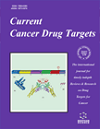- Home
- A-Z Publications
- Current Cancer Drug Targets
- Previous Issues
- Volume 9, Issue 5, 2009
Current Cancer Drug Targets - Volume 9, Issue 5, 2009
Volume 9, Issue 5, 2009
-
-
Ribonucleotide Reductase as One Important Target of [Tris(1,10- phenanthroline)lanthanum(III)] Trithiocyanate (KP772)
More LessKP772 is a new lanthanum complex containing three 1,10-phenathroline molecules. Recently, we have demonstrated that the promising in vitro and in vivo anticancer properties of KP772 are based on p53-independent G0/G1 arrest and apoptosis induction. A National Cancer Institute (NCI) screen revealed significant correlation of KP772 activity with that of the ribonucleotide reductase (RR) inhibitor hydroxyurea (HU). Conse Read More
-
-
-
Deacetylase Inhibitors Modulate the Myostatin/Follistatin Axis without Improving Cachexia in Tumor-Bearing Mice
More LessAuthors: A. Bonetto, F. Penna, V. G. Minero, P. Reffo, G. Bonelli, F. M. Baccino and P. CostelliMuscle wasting, as occurring in cancer cachexia, is primarily characterized by protein hypercatabolism and increased expression of ubiquitin ligases, such as atrogin-1/MAFbx and MuRF-1. Myostatin, a member of the TGFβ superfamily, negatively regulates skeletal muscle mass and we showed that increased myostatin signaling occurs in experimental cancer cachexia. On the other hand, enhanced expression of follistati Read More
-
-
-
P-Selectin Glycoprotein Ligand-1 as a Potential Target for Humoral Immunotherapy of Multiple Myeloma (Supplementry Material)
More LessAuthors: C. Tripodo, A. M. Florena, P. Macor, A. Di Bernardo, R. Porcasi, C. Guarnotta, S. Ingrao, M. Zerilli, E. Secco, M. Todaro, F. Tedesco and V. FrancoMonoclonal antibodies (mAbs), successfully adopted in the treatment of several haematological malignancies, have proved almost ineffective in multiple myeloma (MM), because of the lack of an appropriate antigen for targeting and killing MM cells. Here, we demonstrate that PSGL1, the major ligand of P-Selectin, a marker of plasmacytic differentiation expressed at high levels on normal and neoplastic plasma cells, may r Read More
-
-
-
Targeting the Mevalonate Pathway for Improved Anticancer Therapy
More LessBy G. FritzThe mevalonate pathway is important for the generation of isoprene moieties, thereby providing the basis for the biosynthesis of molecules required for maintaining membrane integrity, steroid production and cell respiration. Additionally, isoprene precursors are indispensable for the prenylation of regulatory proteins such as Ras and Ras-homologous (Rho) GTPases. These low molecular weight GTP-binding proteins pla Read More
-
-
-
The Role of Fibroblast Growth Factors in Tumor Growth
More LessAuthors: M. Korc and R. E. FrieselBiological processes that drive cell growth are exciting targets for cancer therapy. The fibroblast growth factor (FGF) signaling network plays a ubiquitous role in normal cell growth, survival, differentiation, and angiogenesis, but has also been implicated in tumor development. Elucidation of the roles and relationships within the diverse FGF family and of their links to tumor growth and progression will be critical in designing ne Read More
-
-
-
Importance of Influx and Efflux Systems and Xenobiotic Metabolizing Enzymes in Intratumoral Disposition of Anticancer Agents
More LessBy B. RochatIn this review, intratumoral drug disposition will be integrated into the wide range of resistance mechanisms to anticancer agents with particular emphasis on targeted protein kinase inhibitors. Six rules will be established: 1. There is a high variability of extracellular/intracellular drug level ratios; 2. There are three main systems involved in intratumoral drug disposition that are composed of SLC, ABC and XME enzymes; 3. T Read More
-
-
-
Targeting of Hsp32 in Solid Tumors and Leukemias: A Novel Approach to Optimize Anticancer Therapy (Supplementry Material)
More LessHeat shock protein 32 (Hsp32), also known as heme oxygenase-1 (HO-1), is a stress-related anti-apoptotic molecule, that has been implicated in enhanced survival of neoplastic cells and in drug-resistance. We here show that Hsp32 is expressed in most solid tumors and hematopoietic neoplasms and may be employed as a new therapeutic target as evidenced by experiments using specific siRNA and a Hsp32-targeting Read More
-
-
-
Emerging Strategies to Strengthen the Anti-Tumour Activity of Type I Interferons: Overcoming Survival Pathways
More LessAuthors: M. Caraglia, M. Marra, P. Tagliaferri, S. W.J. Lamberts, S. Zappavigna, G. Misso, F. Cavagnini, G. Facchini, A. Abbruzzese, L. J. Hofland and G. VitaleInterferon-α (IFN-α) is currently the most used cytokine in the treatment of cancer. However, the potential anti-tumour activity of IFN-α is limited by the activation of tumour resistance mechanisms. In this regard, we have shown that IFN-α, at growth inhibitory concentrations, enhances the EGF-dependent Ras→Erk signalling and decreases the adenylate cyclase/cAMP pathway activity in cancer cells; both effects represent escape Read More
-
Volumes & issues
-
Volume 25 (2025)
-
Volume 24 (2024)
-
Volume 23 (2023)
-
Volume 22 (2022)
-
Volume 21 (2021)
-
Volume 20 (2020)
-
Volume 19 (2019)
-
Volume 18 (2018)
-
Volume 17 (2017)
-
Volume 16 (2016)
-
Volume 15 (2015)
-
Volume 14 (2014)
-
Volume 13 (2013)
-
Volume 12 (2012)
-
Volume 11 (2011)
-
Volume 10 (2010)
-
Volume 9 (2009)
-
Volume 8 (2008)
-
Volume 7 (2007)
-
Volume 6 (2006)
-
Volume 5 (2005)
-
Volume 4 (2004)
-
Volume 3 (2003)
-
Volume 2 (2002)
-
Volume 1 (2001)
Most Read This Month
Article
content/journals/ccdt
Journal
10
5
false
en


